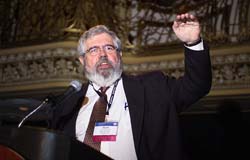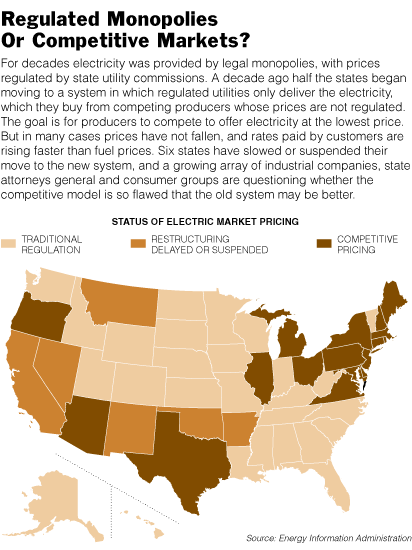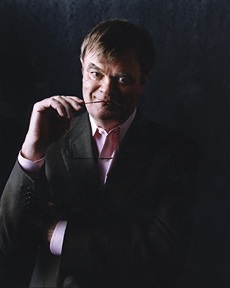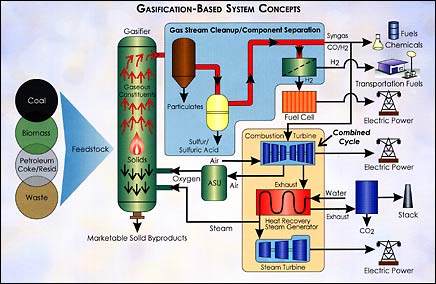Deregulation = Failure – DUH!
October 15th, 2006
The New York Times’ David Cay Johnston is at it again! His byline makes my day (for another view, check this), and that he’s on to “deregulation” gives me a glimmer of hope. Johnston’s the guy who wrote Perfectly Legal: The Covert Campaign to Rig Our Tax System to Benefit the Super Rich–and Cheat Everybody Else — writer and digger extraordinaire. It’s not so much that he finds it all, but that he’s connecting the dots and stating the result, in a time where establishing these connections exposes the myths, fictions and abject lies.

First, I’ll signal my turn — this is about STRANDED ASSETS. I remember way back when, when “deregulation” was pushed by NSP/Xcel, when there was a big effort by NSP and the MN Chamber of Commerce to eliminate utility personal property tax in anticipation of certain deregulation. I remember being aghast at the enviros’ capitulation and acquiesence, assuming deregulation would happen, and I got into more than a few fights about that, knowing that if we rolled on that, it’s all over. I had a great talk with Steve Corneii, then of the A.G.’s office, outside some Senate hearing room, and I really got down on him about acquiescing, that if we acquiesced, well duh, we deserve what we get, and we’d damn well better stand up, he’s representing the state, and he more than anyone has to be standing up… well, a friend observing said I had him up against the wall and she was worried… sigh… some just don’t understand spirited repartee. Anyway, about six months later, an A.G. report was issued on deregulation, authored by Steve Corneli, which is really important, so here it is:
What’s important about this is that while utilities, NSP in this case, were claiming that ratepayers would have to pay the utilities for “stranded costs,” what we have in Minnesota was “stranded assets,” to the tune of $764 million. $764 million in stranded ASSETS, not stranded COSTS! Logically, then, if utilities would be paid by ratepayers for “stranded costs,” then conversely, utilities would have to pay ratepayers for STRANDED ASSETS! DUH! Well, for some odd reason, talk of deregulation in Minnesota started waning, and by the time Hatch’s Deregulation Report, “The Electricity Deregulation Experience” was issued, deregulation was dead in the water. From here, I’d say it turned on stranded assets, and exposure of the utilities attempt to screw us over. Or as put by Corneli:
What happens if we apply the same deal to Minnesota? If Minnesota consumers get to buy from alternative providers, many of whom have higher costs of production, at higher market clearing prices, there is no consumer benefit. There is consumer harm, at least to the residential and small business customers who don’t have the buying power to sign rock-bottom price contracts with low cost producers. By the way, why would huge international firms like USX be signing these long-term contracts with Minnesota Power if they don’t expect higher prices from deregulation? And while consumers will be harmed by higher electricity prices, the same higher prices will make the value of generating assets increase for shareholders. They will get windfall profits, while consumers get higher prices. That’s what the map shows. That’s the deal that could result from enacting a policy in Minnesota that is pro-consumer in Illinois.
What does any of this have to do with building new coal plants on the eve of further regulation? HELLO! It’s all connected! By building new coal plants today, we could very well be creating “stranded costs” because of imprudent expenditures on generation without a future, and setting ourselves up for massive payments to utilities for their imprudent investments. Is anyone paying attention? At least one of the reports I’ve read on CO2 capture and sequestration notes this potential, so methinks it’s a lot more than a little sidebar in a huge report. Utility expenses will be covered by ratepayers, but the PUC has the responsibility to assure that it is a prudent investment, that’s their charge. Are they considering this as they go forward with new coal plants? Is anyone raising this issue? And remember, what do utilities care? As long as the PUC approves it as a prudent investment, they’ll be covered, and we’ll pay.
I wish Johnston would dig into the impact of wholesale deregulation in regulated states, because we’re ending up with defacto deregulation, the regulated parts are drowning under the weight of wholesale transactions that are the utility priority.
So back to David Cay Johnston — he’s speaking the truth about deregulation, the utilities just think it’s hell. Are we paying attention?
Competitive Era Fails to Shrink Electric Bills
October 15, 2006
By DAVID CAY JOHNSTON
A decade after competition was introduced in their industries, long-distance phone rates had fallen by half, air fares by more than a fourth and trucking rates by a fourth. But a decade after the federal government opened the business of generating electricity to competition, the market has produced no such decline.
Instead, more rate increase requests are pending now than ever before, said Jim Owen, a spokesman for the Edison Electric Institute, the association for the investor-owned utilities that provide about 60 percent of the nation’s power. The investor-owned electric utility industry published a June report entitled “Why Are Electricity Prices Increasing?”
About 40 percent of all electricity customers, those in 23 states and the District of Columbia where new competition was approved, mostly paid modestly lower prices over the past decade. But those savings were primarily because states, which continue to have some rate-setting power, imposed cuts, freezes and caps at the behest of consumer groups that wanted to insulate customers from any initial price swings.
The last of those rate protections expire next year, and the Federal Energy Regulatory Commission and other federal agencies warn in a draft report to Congress that “customers may experience rate shock” as utilities seek to make up for revenue they did not collect during the period of artificially reduced prices and to cover higher costs of fuel. They warned that “this rate shock can create public pressure” to turn back from electricity prices set by the market to prices set by government regulators.
The disappointing results stem in good part from the fact that a genuinely competitive market for electricity production has not developed.
Concerned about rising prices, California and five other states have suspended or delayed transition to the competitive system.
And voters around two California cities, Sacramento and Davis, will decide next month whether to replace investor-owned utilities with municipal power in hopes of lowering rates. Drives are under way to expand public power in Massachusetts. In Portland, Ore., the city council tried and failed to buy the local utility company.
Electric customers in other states are facing rude surprises.
In Baltimore, an expected 72 percent rate increase in electricity prices has aroused so much protest that the state legislature met in special session, where it arranged to phase in the higher costs over several years. In Illinois, rates are about to rise as much as 55 percent.
The three New York area states opened their electricity markets to competition, with different results.
In Connecticut, residential electric rates rose up to 27 percent last year to an average of $128 a month, and are expected to go up as much as 50 percent more in January.
In New Jersey, rates rose up to 13 percent this year, and are poised to go much higher.
New York residential customers, by contrast, paid an inflation-adjusted average of 16 percent less in 2004 than in 1996, a state report said. It is not known how much of that is attributable to government-ordered rate cuts, but the state benefited from huge increases in power generated by its nuclear plants and by buying power from New England plants that, starting next year, may have less electricity to sell to New York.
The Federal Energy Regulatory Commission and five other agencies, in the draft of the report to Congress, are unable to specify any overall savings. “It has been difficult,” the report states, “to determine whether retail prices” in the states that opened to competition “are higher or lower than they otherwise would have been” under the old system.
Joseph T. Kelliher, the commission chairman, said Friday that eventually “market discipline will deliver the best prices” and noted that every administration and Congress since 1978 had pushed the industry toward competition. He added that the commission recognized a need for “constant reform of the rules.”
Under the old system, regulated utilities generated electricity and distributed it to customers. Under the new system, many regulated utilities only deliver power, which they buy from competing producers whose prices are not regulated. For example, Consolidated Edison, which serves the New York City area, once produced almost all the power it delivered; now it must buy virtually all its electricity from companies that bought its power plants and from other independent generators.
The goal is for producers to compete to offer electricity at the lowest price, savings customers money.
Independent power producers, free-market economists and the Clinton Administration cheered in 1996 when the federal government allowed states to adopt the new system. The new rules “will benefit the industry and consumers to the tune of billions of dollars every year,” Elizabeth A. Moler, then chairwoman of FERC, said at the time. She said the new rules would “accelerate competition and bring lower prices and more choices to energy customers.”
But that has not happened. A truly competitive market has never developed, and, in most areas, the number of power producers is small. In New Jersey, for example, only six companies produce power, and not all of them sell to every utility.
Some utilities have decided to buy electricity not from the cheapest supplier but from one owned by a sister to the utility company, even if that electricity is more expensive. That has been the case in Ohio.
And if electricity is needed from more than one producer, utilities pay each one the highest price accepted in the bidding, not the lowest. This one-price system, adopted by the industry and approved by the federal government, is intended to encourage investment in new power plants, which are costlier than older ones.
But critics say that, as in California five years ago in a scandal that enveloped Enron, the auction system can be manipulated to drive up prices, with the increases passed on to customers. What is more, companies that produce electricity can withhold it or limit production even when demand is at its highest, lifting prices. This happened in California, and the federal commission has found that it occurred in a few more instances since then. Critics say that more subtle techniques to reduce the supply of power are common and that the commission shows little interest in investigating.
Bryan Lee, a FERC spokesman, said complaints of manipulation are investigated, but only last year did Congress give the commission the legal tools to punish manipulators.
Under the new system there have been some big winners “including Goldman Sachs and the Carlyle Group, the private equity firm” that figured out that there were huge profits to be made in one area of the new system.
Such investors have in some cases resold power plants they just bought, making a large profit. In other cases, investors have bought power plants from the utilities at what proved to be bargain prices, then sold the electricity back at much higher prices than it would have cost the utility to generate the electricity.
Richard Blumenthal, the Connecticut attorney general, said the supposedly competitive market has been “a complete failure and colossal waste of time and money.”
He asked the federal commission to revoke competitive pricing in his state, but the commission dismissed the complaint last Wednesday, saying the state had not proved its case.
Advocates of moving to the new system say that, in time, the discipline of the competitive market will mean the best possible prices for customers. Alfred E. Kahn, the Cornell University economist who led the fight to deregulate airlines and who, as New York’s chief utility regulator in the 1970s, nudged electric utilities toward the new system, said that he was not troubled by the uneven results so far.
“Change,” Professor Kahn said, “is always messy.”
But some advocates of introducing competition to the electric industry have soured on the idea. They include the Cato Institute, a leading promoter of libertarian thought that favors the least possible regulation and that concluded earlier this year that government and electric utilities have made such hash of the new system that the whole effort should be scrapped.
“We recommend total abandonment of restructuring,” Cato said. If the public rejects a greater embrace of markets, Cato wrote, the next best choice would be a “return to an updated version of the old” system.
The conflicting results among the many studies of electric prices stand in contrast to the sharp, unambiguous drops in the prices of telephone calls, air travel and trucking.
One study by the utility economist Mark L. Fagan, a senior fellow at the Kennedy School of Government at Harvard and a consultant to various businesses who favors a competitive system, found that the new system often produces better results. He found that in 12 of 18 states that restructured, prices were lower for industrial customers than they would have been under the old system. But he also found that prices were somewhat lower than his model predicted in seven of 27 states that did not open to competition.
In Virginia, a state that did not move to the new system, a report last month by the agency that regulates utilities found “no discernible benefit” to customers in the 16 states that had gone the farthest and warned that electricity prices in those states “may actually be increasing faster than for customers in states that did not restructure.”
And Professor Jay Apt, a former astronaut who runs the electricity study center at Carnegie-Mellon University, found that savings from introducing competition to sales of electricity to large industrial customers “are so small that they are not meaningful.”
Regardless of the debate over the effectiveness of the new system, electricity prices are expected to rise in the next few years for several reasons apart from any rise in the price of coal, natural gas, oil, uranium and other fuels.
A study issued in June by the Edison Foundation, which represents investor-owned utilities concluded that utilities would have to raise rates to upgrade local distribution systems and to finance long-distance transmission lines, as well as for new power plants. The study found that utility profit margins had thinned and financial strength had weakened. It called for relief in the form of higher rates.
================================================
States that deregulated (stolen from NYT, fair use, eh?):

Greetings from Christine Ziebold, M.D., Ph.D., M.P.H.
October 14th, 2006
.
Christine Ziebold and family moved to Iowa last month. Just before she left, I was able to introduce her to Ed Anderson, the Grand Rapids doctor who is testifying in the Excelsior Power Purchase Agreement case. Why should they know each other? Because in July, a report that she co-authored was released. “The Price of Pollution” addresses the dollar costs of the medical/health costs of pollution, in the case of coal plants, problems such as increased asthma, cardiovascular problems, chronic obstructive pulmonary disease (emphysema), and then there’s all the neurological problems associated with mercury. The report was sponsored by Institute for Ag and Trade Policy and Minnesota Center for Environmental Advocacy — now someone explain to me why MCEA didn’t introduce “The Price of Pollution” into evidence in EITHER Mesaba or Big Stone! If they don’t use it, shouldn’t they give all the money back to the Bush Foundation? Anyway, Christine’s report was just the right thing at the right time. She’s reviewed Ed’s testimony, and said, “It is splended! Absolutely wonderful!”
In case you missed the link to Christine’s report, here it is again:
And here’s Ed Anderson, M.D.’s testimony, in case you missed that:
And here’s Christine and baby Matthias at Devonian Park, Lake Coralville, practicing flying — for some reason, he’s been doing this a lot lately, so she’s been encouraging him as he prepares to make that big leap into adulthood!

Czechmor across Southern MN – and Keillor too!
October 14th, 2006

Remember, TOMORROW:
Czech out Czechomor & Lenka Dusilova
Sunday, October 15th
New Prague High School Auditorium
Doors open at 7, music starts at 8
And if Sunday doesn’t work, well, there’s Monday! Just in from Peggy Hanson (looks like another of those Erick Sommers’ Press Releases, which I’ve stolen verbatim, those exclamation points are NOT mine!!!):
Breaking News: The internationally acclaimed band “Czechomor” will join Garrison Keillor on Monday! Czechomor played to a packed house at the Kennedy Center for the Performing Arts only last weekend! The performance will start at 7:00 pm sharp, at WSU’s Somsen Auditorium. Tickets are only $15 and are available at the door!
Not only will Garrison regale us with stories of Lake Wobegon and his thoughts on the politics of the day, but we’ll be treated to the inspiring music of this outstanding group.
The winner of four Czech Music Academy Awards (the Czech version of the Grammy), Czechomor’s music is rooted in Moravian village music. The band’s unique mélange of traditional folk mixed with Ottoman dissonance, Gypsy czardas, Napoleonic mustering dances and Celtic rhythms have succeeded in winning over young and old alike, with over 200,000 albums sold.
This is an event no one will want to miss!! Please forward this message to all your friends!!!! As ex-president Václav Havel’s favorite ensemble, Czechomor has entertained celebrity audiences at charity concerts across the European continent, including the Royal Albert Hall in London. See www.czechomorustour.com
The opportunity remains to rub elbows with Garrison Keillor at the pre-event dinner/reception, Lake Lodge from 5:00 to 6:30 pm. Several tickets are still available at the DFL office, 685 West 5th Street, Winona.

Got that?
Czechomor & Garrison Keillor
Monday @ 7 p.m. $15 at door
WSU’s Somsen Auditorium
Winona !!!!!!!!!!

Candidate forum in Red Wing
October 14th, 2006
This past week was a time of subtle upheavals, and good ones at that, but I’m still trying to figure out what it all means, much less get all these emails and documents absorbed, forwarded and filed. I even forgot Kenya’s birthday, not that she gives a rodent’s rump, but she’s getting old, and has started noticably slowing down and feeling her age.
Anyway, it’s the season of politics, and yesterday I had been invited to speak to/with a delightfully challenging group of movers and shakers in the Cities — and they were very interested in this fight with the Red Wing City Council about background checks. Over a dozen people have downloaded the A.G.’s opinion, telling the City they’re out of line.
Here’s the AG Opinion again, in case you missed it, it’s WELL WORTH the read:
And get out your calendar, we’re having the full range of candidates here on October 26th (stolen from the Beagle editorial):
â?¢ Red Wing City Council candidates, 2 p.m., St. James Hotel.
â?¢ House 28A candidates, 2:55 p.m.
â?¢ House 28B candidates, 3:40 p.m.
â?¢ U.S. House District 2 candidates, 6 p.m.
â?¢ U.S. Senate candidates, 6:50 p.m.
â?¢ Minnesota gubernatorial candidates, 7:40 p.m.
Sponsored by KCUE, the Republican Eagle and Red Wing Area Chamber.
â?¢ Red Wing City Council candidates, 7 p.m., City Hall.
Sponsored by the League of Women Voters Red Wing.
Be there and ask the important questions – put their feet to the fire!
Two Mesaba letters in GRHR
October 12th, 2006

More on Excelsior’s Mesaba Project:
Think of consequences with Mesaba Energy project
Herald-Review
Last Updated: Thursday, October 12th, 2006 03:28:09 PM
Editor:To the people of Itasca and St. Louis counties and the state of Minnesota. Wake up!
Do you realize what the consequences the Excelsior Energy coal gasification plant to be located near the town of Taconite is going to be to our state?
After recently attending a CAMP (Concerned Citizens against the Mesaba Project) meeting at Cloverdale north of Nashwauk, I came away knowing our area is in danger of pollution to not only ourselves but to the animals, fish and habitat. Did you know that 720 lakes and an area of 340 kilometers would be affected by this pollution? Are we willing to sacrifice this for the sake of electrical power that will not be provided to us in the immediate area, but to people in the Cities, Rochester, LaCrosse, Wis., and points further?
Do the people of Minnesota care about our plight? The majority does not know of it as they think it does not concern them. Well, if they hunt, fish, or have property in this northern area of the state, they better be concerned. Remember the winds blow west to east and north to south.
Sure politicians will argue that this will bring jobs to the area. What more can help them in an election year but the promise of more jobs. Their reelection is critical to them. Many have already promised money for this project. In the end there will be approximately 110 permanent jobs that will require a college education and job experience. Yes, during the construction phase of the plant there will be a lot of jobs, but that will be only for a few years. There is a possibility that more plants will be built across the Iron Range. Is our sacrifice of clean air, water and land worth it?
Itasca County does not have a huge population. That is one of the reasons for the plant being built in the Taconite area.
For additional information please go to mncoalgasplant.com. Or follow developments on Web site camp-site info. If you would like to receive updates or find out how you can help CAMP, please e-mail camp@northic.com.
Again, are we willing to make this sacrifice for our children and ourselves?
Joanne Gangl
Nashwauk
And here’s a letter from Crowe again, stumping for Excelsior:
Mesaba Energy is working toward the good of the area’s future
Herald-Review
Last Updated: Thursday, October 12th, 2006 03:29:03 PMEditor:
Complements to Dave Johnson on his well thought out letter on the Mesaba Energy project and invitation to the proponents of other forms of electric production to alter their lifestyles to fit their favorite type.
It is interesting that we hear the same arguments from the detractors of the project, most proven untrue long ago but still regurgitated over and over again. The remainder are generally irrelevant to the case, just thrown in to pollute the argument.
In my opinion, Gary Burt, of Taconite, to use his own analysis, makes some vacuous assumptions in his crude attempt to counter Mr. Johnson. The first assumption is that since no one has asked Wind Logic to test the Iron Range for its wind generation potential, then wind generation must be a viable alternative to the Mesaba Energy project. The second assumption is that this first assumption is correct. He then blithely goes on to advocate for the construction of windmills instead of the coal gasification plant, why let the facts influence anything?
The real fact about wind energy is that even though it is clean, it is unreliable in the best of circumstances. Given the choice, people choose reliable energy.
Another argument I’ve seen that I believe is similarly vacuous is this: “If we don’t use it here, we don’t need to generate it here.” Let’s apply this standard to all the other activities going on around the area. We send all the taconite we mine and refine to other places, we don’t use that here so let’s end all taconite production. Thousands of jobs lost. We don’t use all the paper we produce here so let’s end paper production. Hundreds of jobs lost. We don’t use all the ASV’s we produce here, we send them nationwide, let’s shut that down, hundreds of jobs lost. We don’t use all the OSB here so end all OSB production. Oops, I guess that is shut down, temporarily, I hope, a hundred and fifty families with greatly reduced income, maybe those jobs are already lost.
I know the people who are trying to build a clean coal gasification plant are looking at the big picture, a good future for the people who want to live in this area and have their children live here. The future looks pretty bleak if you follow the arguments of the detractors to their ultimate end.
Robert Crowe
Hill City